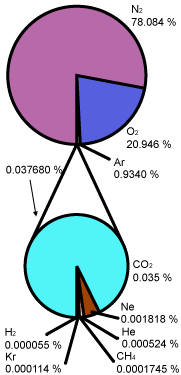The air we breathe is made up of a mixture of gases.
Major Gases, Nitrogen, Oxygen and Argon
The air is mostly made up of nitrogen and oxygen (99.03%). Both are colorless and oderless. Nitrogen gas is largely inert does not readily react with other substances. oxygen is required for all animal life on earth from humans to bacteria for respiration (breathing). Oxygen is quite reactive in contrast to nitrogen. This reaction is called oxidation and examples can be seen almost everywhere from the browning of a newly sliced apple to the rusting of iron. Rapid oxidation is what we call fire. Argon is a very inert gas and is normally non-reactive.
Carbon in the Air
Carbon is in the air in the form of carbon dioxide (CO2). Carbon dioxide is required by plant life for photosynthesis, the process of using sunlight to create simple sugars (energy) the plants need to grow and live. This process of photosynthesis by plants also releases oxygen that animal life needs. One important property of carbon dioxide is it's ability to absorb infrared radiation (heat) and reradiate it. This is the carbon problem also known as Global Warming.
Sources of Carbon in the Air
Carbon in the air as carbon dioxide come from a variety of sources.
The breakdown (decomposition or rotting) of organic material such as plant life and garbage.
Volcanos and seismic earth activities.
Burning of carbon based materials for energy such as coal, oil, and wood.
Some carbon dioxide sources are natural such as decaying organic material, volcanos and forest fires. Others are man made such as burning of coal and oil for electricity and heat or burning oil as fuel for transportation (trucks, automobiles, aircraft, etc.).
Reducing man made sources of carbon dioxide will reduce the amount of carbon in the atmosphere. This sounds easy, what is the problem?
